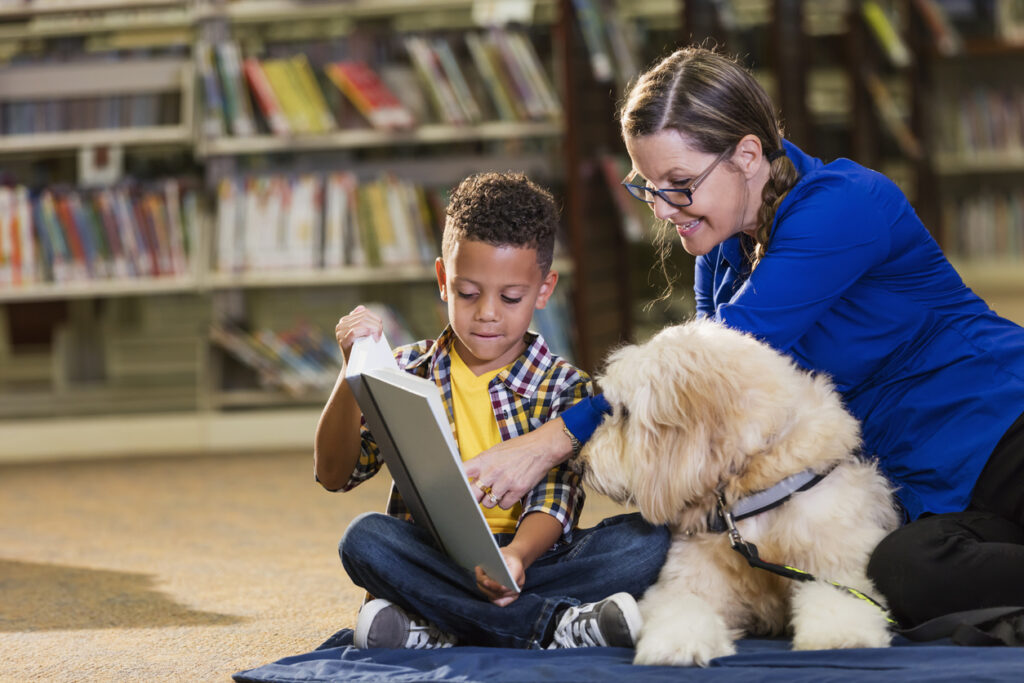Lead trainer Michele Forto of Alaska Dog Works offers a proprietary therapy dog training program that sets it apart from any other in the country. It is called Dogs Assisting with Grace™ (DAWGs) and its motto is: From Paws to Purpose. This article discusses: Discovering the Best Age to Train Your Therapy Dog. Therapy dogs provide comfort, emotional support, and affection to individuals in various settings, such as hospitals, schools, and nursing homes. The process of training a therapy dog is both rewarding and complex, requiring careful consideration of the dog’s temperament, training methods, and, most importantly, the right age to begin training. This blog post examines the optimal age to start training a therapy dog, taking into account various factors that influence a dog’s ability to succeed in this role.
Understanding Therapy Dogs
Before delving into the optimal age for training, it’s essential to understand what therapy dogs do. Unlike service dogs, which are trained to perform specific tasks for individuals with disabilities, therapy dogs are trained to provide comfort and companionship. They visit various facilities to interact with people, offering emotional support and joy.
Key Characteristics of Therapy Dogs
- Calm Temperament: Therapy dogs must be calm and gentle, even in unfamiliar environments.
- Sociability: They should enjoy interacting with different people and other animals.
- Trainability: A willingness to learn and obey commands is crucial.
- Adaptability: They should be comfortable in diverse settings, from quiet rooms to bustling public spaces.
The Best Age to Start Training
Early Socialization: Puppies (8-16 Weeks)
The early weeks of a puppy’s life are critical for socialization. Starting training during this period can be beneficial, as it lays the foundation for future learning and behavior. Puppies are highly impressionable between 8 and 16 weeks, making this an ideal time to introduce them to various stimuli, such as different people, environments, and other animals.
Benefits of Early Training
- Social Skills: Early exposure helps puppies develop essential social skills.
- Confidence Building: Positive experiences with new environments boost a puppy’s confidence.
- Basic Commands: During this time, puppies can start learning basic commands such as sit, stay, and come.
Adolescence: Young Dogs (4-6 Months)
As puppies mature into young dogs, they become more receptive to structured training. This stage is crucial for reinforcing the foundation laid during the early weeks. Training during adolescence focuses on building obedience and refining social skills.
Training Focus
- Obedience Training: Consistent reinforcement of commands is essential.
- Leash Training: Teaching proper leash behavior is crucial for therapy work.
- Advanced Socialization: Continued exposure to different environments and people.
Maturity: Adult Dogs (1-3 Years)
Adult dogs are typically more settled and focused, making training more straightforward. If a dog has not started training at a younger age, this period is still suitable for beginning therapy dog training.
Advantages of Training Adult Dogs
- Emotional Stability: Adult dogs often display more stable temperaments.
- Physical Maturity: They have better control over their movements.
- Focused Learning: Adult dogs can concentrate for longer periods.
Factors Influencing the Best Age for Training
Breed Considerations
Different breeds mature at varying rates, which impacts the optimal age to start training. For instance, smaller breeds often mature faster than larger breeds. Understanding breed-specific traits is essential for determining the right training timeline.
Individual Temperament
Each dog is unique, and individual temperament plays a significant role in determining when to start training. Observing a dog’s behavior, sociability, and response to new experiences helps assess readiness for training.
Health and Wellness
A dog’s physical health can impact training readiness. Ensuring a dog is healthy and free from any discomfort or medical issues is crucial before beginning any training regimen.
Training Techniques for Therapy Dogs
Positive Reinforcement
Using positive reinforcement techniques, such as treats and praise, encourages desired behaviors without causing stress or fear. This approach is efficient for therapy dogs, as it fosters trust and strengthens the bond between humans and animals.
Consistency and Patience
Consistency in training commands and expectations is vital. Patience is equally important, as each dog learns at its own pace. Rushing the process can lead to frustration for both the dog and the trainer.
Professional Training Programs
Enrolling in a professional therapy dog training program can be beneficial. These programs offer structured guidance and expose dogs to the specific skills needed for therapy work.
Conclusion
Determining the best age to start training a therapy dog involves considering various factors, including the dog’s age, breed, temperament, and individual needs. Early socialization during the puppy stage, structured training during adolescence, and focused learning with adult dogs all contribute to a successful journey in therapy dog training.
Each stage of a dog’s life offers unique opportunities to develop the skills necessary for therapy work. With the right approach and understanding, any well-suited dog can become a comforting presence in the lives of those who need it most. Whether starting with a puppy or an adult dog, the key is to focus on building a strong foundation of trust, obedience, and social skills, ensuring a rewarding experience for both the dog and the individuals they serve.
We offer a FREE Strategy Call.
Click on the graphic to learn more
Read More









